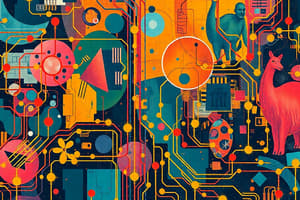Podcast
Questions and Answers
Which component is responsible for converting physical stimuli into electronic signals?
Which component is responsible for converting physical stimuli into electronic signals?
- Networks
- Databases
- Sensors (correct)
- Actuators
What technology improves the ability to analyze relationships among sensed data?
What technology improves the ability to analyze relationships among sensed data?
- Augmented Intelligence (correct)
- Augmented Behavior
- Data Aggregation
- Public IP Addressing
What action does data aggregation primarily enable?
What action does data aggregation primarily enable?
- Efficient data processing (correct)
- Data visualization
- Data communication
- Technical standard compliance
Which stage in the information value loop is responsible for synthesizing data from various sources?
Which stage in the information value loop is responsible for synthesizing data from various sources?
What does the term 'public IP addressing' refer to in the context of ubiquitous computing?
What does the term 'public IP addressing' refer to in the context of ubiquitous computing?
What distinguishes Active RFID Tags from Passive RFID Tags?
What distinguishes Active RFID Tags from Passive RFID Tags?
Which layer of the three-layer architecture is responsible for data collection and transmission?
Which layer of the three-layer architecture is responsible for data collection and transmission?
In a five-layer IoT architecture, what is the primary function of the Service Management Layer?
In a five-layer IoT architecture, what is the primary function of the Service Management Layer?
Why is a unique IP address necessary for all smart things connected to the internet?
Why is a unique IP address necessary for all smart things connected to the internet?
Which of the following is NOT a characteristic of Active RFID Tags?
Which of the following is NOT a characteristic of Active RFID Tags?
Flashcards are hidden until you start studying
Study Notes
Ubiquitous Computing Overview
- Ubiquitous computing features real-life objects that can sense, communicate, analyze, and act based on situational data.
- Key enablers include miniaturization, portability, ubiquitous connectivity, integration of diverse devices, and digital ecosystems like cloud computing.
Internet of Things (IoT) Functional View
- Five stages of the IoT information value loop:
- Create: Sensors responsible for data generation.
- Communicate: Networks facilitate data transmission.
- Aggregate: Integration standards support data interoperability.
- Analyze: Augmented intelligence tools provide insights on data relationships.
- Act: Augmented behavior technologies enhance compliance with action protocols.
Identification and Sensing Technologies
- Identification methods assign unique identities to objects in a network, with public IP addresses identifying smart devices on the Internet.
- Sensing involves data originating from connected smart devices through sensors and actuators.
- Sensors: Electronic devices producing electrical, optical, and digital data from environmental stimuli, which is transformed into useful information.
- Actuators: They convert electrical signals into non-electric energy, acting on data provided by sensors.
RFID System Components
-
RFID Tags (Transponders/Smart Labels):
- Comprised of an antenna, optional battery, and semiconductor chip.
- Two types:
- Active Tags: Equipped with battery, offering large memory and extended read range.
- Passive Tags: Lacks on-board power; simpler and less expensive.
-
Interrogator (Reader):
- Includes RF module, control module, and antenna for reading RFID tags.
-
Controller (Host):
- Hosts the database for storing tag-related information.
Connectivity and Networking
- RFID devices, sensors, and networks connect through various technologies, including Bluetooth, Wi-Fi, and gateways.
- A unique IP address is necessary for each smart device to ensure uninterrupted connectivity.
IoT Architecture
-
Three-Layer IoT Architecture:
- Application Layer: Provides services and semantic analysis.
- Network Layer: Routes data to applications.
- Perception Layer: Handles data collection and transmission.
-
Five-Layer IoT Architecture:
- Perception Layer: Collects data from smart devices.
- Object Abstraction Layer: Provides network connectivity.
- Service Management Layer: Manages data processing and storage.
- Application Layer: Offers services, semantic analysis, and reporting.
- Business Layer: Develops business models, flowcharts, and graphs.
Studying That Suits You
Use AI to generate personalized quizzes and flashcards to suit your learning preferences.




